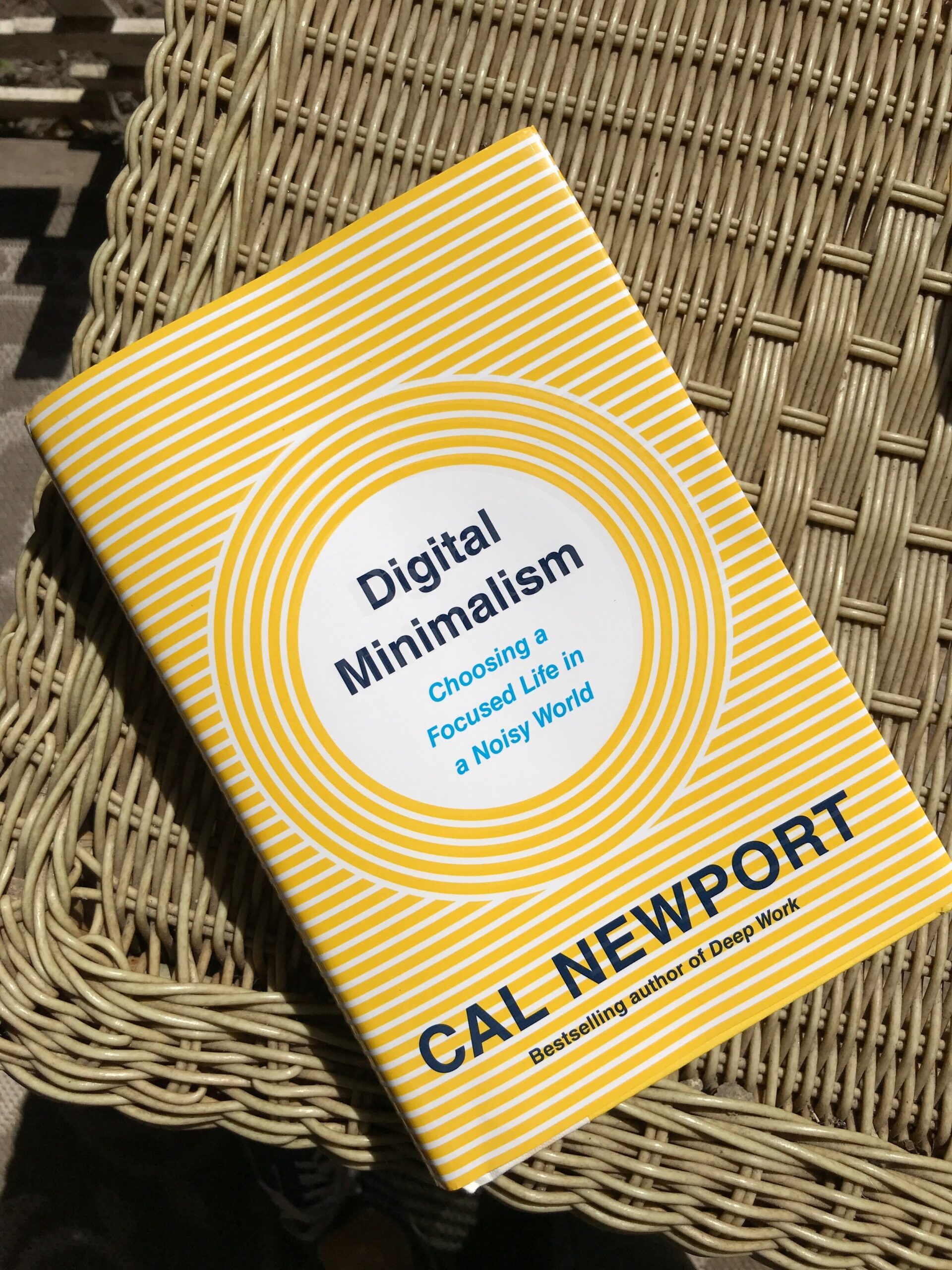There’s a constant hum in my head in everything I do. While I’m chopping carrots and sweet potatoes. While I’m sitting in the backyard watching Will play. When I have 10 minutes to get 30 minutes worth of work done. It’s the airplane taking off, MacBook is about to die, all-encompassing, steady, consistent hum of my phone nearby. It’s not rhythmic and it’s not soothing. It’s a low-grade numbing device that has me wrapped around its finger.
And, according to Cal Newport’s book Digital Minimalism, this was all on purpose.
A few weeks into maternity leave, my brother texted me a picture of this book and said I would love it. I started reading it during midnight and 3 a.m. feedings and quickly became obsessed.
Early on in his book, Newport cites Bill Maher’s assertion about cell phones and social media:
“The tycoons of social media have to stop pretending that they’re friendly nerd gods building a better world and admit they’re just tobacco farmers in T-shirts selling an addictive product to children. Because, let’s face it, checking your “likes” is the new smoking.”
To me, this reframed the hum I had been trying to quiet to no avail. The reason I haven’t been able to shake the hum or convince myself I didn’t need to scroll instagram after a long day, is because I wasn’t meant to. According to Cal Newport and Tristan Harris’ TED Talk “How a handful of tech companies control a billion minds everyday.”, there is a group of researchers in Silicon Valley whose main job is to discover what begs for our attention… and then capitalize on it and monopolize it. All of this, under the guise of fancy words like “connection” and “community.”
Newport is, as you can tell, very one-sided in his view of social media and phone use. While I was reading it, I opted to listen and accept everything he said as-is and then, after I had read and followed his suggestions, I would make my own claims about what that means for my own life. There are lots of valid arguments for the good use of social media, and I have many examples of them myself, the least of which is how we used Twitter to spread gratitude.
But for now, let me tell you my key takeaways from Newport and his thorough research:
“The cost of a thing is the amount of what I will call life which is required to be exchanged for it, immediately or in the long run.”
Understanding the cost of my time on social media has changed me. To give this notion context, let me give you an example.
Like many people, I love a good deal. There’s a local mom-to-mom instagram account where you can buy and sell items. Comparatively, it’s simpler than eBay or OfferUp, and there’s the added appeal of working with people who are your neighbors.
But let’s add up what I exchanged in order to sell a $10 lamp. I wanted to avoid schlepping stuff in my car and taking it to the Goodwill, and I wanted a little extra cash with no strings attached. A decent deal. But here’s the cost:
-
Time to take a picture of it and post it to the shared account: 20 minutes
While this could be a two minute activity, I’m doing this while also taking care of kids and cleaning the house, so it a. Takes longer and b. Takes away time from my kids and causes them to be irritated, which then takes up more time, hence the 20 minutes.
-
Time to check to see if anyone responded to me: 10 minutes
Again, this could be 1 minute.
Instead, when I hop on to just check my direct messages, I also am stopped mid glance by Debbie’s cute kids or Sarah’s honeymoon pictures or World Cup soccer pictures in the search feed.
Instead of 1 minute, it’s 10. And then I’m annoyed with myself for getting lost on Instagram instead of FaceTiming Debbie and her kids or texting Sarah and asking how the honeymoon is. (World Cup Soccer pics are allowed.)
-
Time to process the plan for payment and pick up of said lamp: 20-30 minutes
Combine both #1 and #2 for all the same reasons
Final cost: Lamp: $10, Time: 60 minutes
While this example is literally talking about a monetary cost, it’s emblematic of the cost we pay for in our mind, in our time, and in our in-person relationships. When I “just check my email,” I end up checking text messages, photo updates, or something on my calendar. This is all a cost that impacts what I value most: my husband, my kids, my time.
“The urge to check Twitter or refresh Reddit becomes a nervous twitch that shatters uninterrupted time into shards too small to support the presence necessary for an intentional life.”
Like I mentioned, I read this book on maternity leave, just a few weeks after Ben was born. While at times it felt contrasted to the sweetness of early morning feedings, I feel like Newport’s work allowed me to be fully present. Instead of adding in images and stories to my brain while I nursed him for hours on end, my mind was decluttered with just the off white pages and black simple font of the text. I literally had less in my mind, so I could use all of my faculties to explore Ben’s face, his toes, and what he looks like with his eyes closed. I got rid of the nervous twitch and in return, I got the sweetest moments that have formed the bond between my baby and I.
The final part of Newport’s argument is to participate in a Digital Detox. Much like Marie Kondo’s approach to decluttering your house, you need to declutter your phone use. He details a very specific 30-day detox of ALL optional technology including, but not limited to: deleting the email app, turning off text message notifications, removing social media from your phone, and creating tight restrictions on how you will communicate with people. Once that is done, THEN you come up with a plan for day to day use.
I did the 30-day detox, and I can attest to the mindset shift that happens when you follow his guidelines meticulously. I feel like a different, more free person. I don’t feel controlled by the room in Silicon Valley. While I may still experience the hum, it’s not the soundtrack of my life anymore. That’s reserved for a loud four year old and happy clappy baby.
I’ll write more about it next week.
Corrie
hey, i'm corrie!
I help people-driven companies, large and small, connect with their kind of people with brand voice strategy + personalized copy. A believer in public schools and Ted Lasso, I love getting to champion the best version of your brand.



